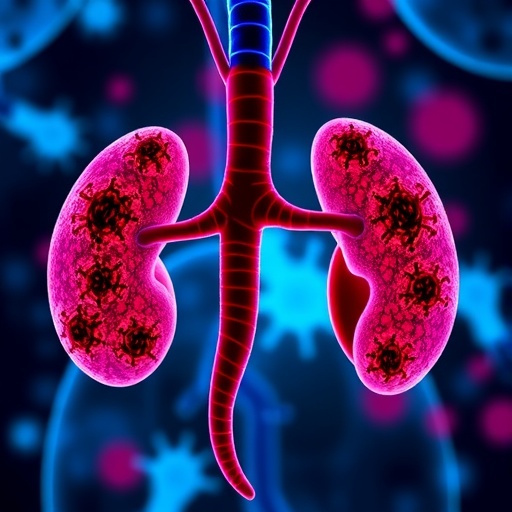Human Endogenous Retroviruses (HERVs) have rapidly emerged as critical players in the landscape of genitourinary cancers, carving out promising avenues for both diagnosis and therapy. These remnants of ancient viral infections, embedded within our genome, are far from mere evolutionary fossils. Instead, they present dynamic and clinically actionable biomarkers, especially in prostate cancer, renal cell carcinoma (RCC), and bladder cancer. Recent insights underscore the transformative potential of HERVs, revealing their intricate roles in tumor biology and therapeutic response modulation.
Prostate cancer, a leading urologic malignancy, demonstrates conspicuous overexpression of various HERV families, making them attractive candidates for diagnostic enhancement and treatment targeting. Although prostate-specific antigen (PSA) remains the cornerstone for prostate cancer screening, its specificity and sensitivity are not optimal, often leading to ambiguous clinical decisions. Cutting-edge microarray technologies targeting multiple HERV proviruses and long terminal repeats (LTRs) have identified a panel of prostate-specific HERV probes, suggesting a potential supplementary biomarker reservoir. However, these findings warrant rigorous clinical validation to establish diagnostic reliability.
One particularly striking discovery involves the elevated levels of HERV-K GAG transcripts in peripheral blood mononuclear cells of prostate cancer patients, a biomarker distinguishably higher than in healthy controls. This elevation correlates with increased plasma interferon-gamma in specific demographics, such as older men and smokers, hinting at a refined stratification method when combined with PSA. Further, the expression of HERV-K GAG protein predominantly in malignant tissues contrasts starkly with its minimal presence in benign counterparts, underscoring its specificity. These molecular signatures collectively suggest that HERV-K components could serve as robust, sensitive diagnostic markers, potentially refining the early detection paradigm in prostate oncology.
Beyond diagnostics, therapeutic vistas leveraging HERV biology are compelling. In prostate cancer cell lines, non-nucleoside reverse transcriptase (RT) inhibitors—commonly used in HIV therapy—have displayed potent cytostatic and differentiation-inducing effects. This phenomenon might be rooted in the suppression of endogenous RT activity inherent to retroelements, suggesting an innovative repurposing of antiretroviral agents. Specifically, abacavir, a nucleoside RT inhibitor, demonstrated significant inhibition of prostate cancer cell proliferation and impeded their invasive capacities, although the mechanistic underpinnings require deeper elucidation. Speculation centers on the modulation of other retroelements, such as LINE-1, which may interplay with HERV-driven oncogenic pathways.
Immunotherapeutic strategies exploiting HERV antigenicity are particularly promising. The GAG protein of HERV-K, highly expressed in advanced prostate malignancies, triggers humoral immune responses, suggesting viability as an immunotherapy target. Vaccine strategies are under exploration that might elicit robust mixed CD8+ and CD4+ T cell responses, enabling active immunization against prostate tumor antigens. Notably, these approaches necessitate scrupulous evaluation of off-target consequences, especially due to the physiological roles of certain HERV-derived proteins like syncytin-1, which is essential for placental development. Encouragingly, targeted therapies such as TCR-engineered T cells and monoclonal antibodies have demonstrated tumor-selective efficacy in other cancers, offering hopeful templates for precision prostate cancer immunotherapy.
Renal cell carcinoma, particularly its clear cell subtype (ccRCC), illustrates another frontier where HERV expression profiles have been harnessed for prognostication and therapeutic optimization. Innovative ERV-based classification systems employing high-throughput ERV expression analyses have stratified metastatic ccRCC patients by predicted response to immune checkpoint inhibitors (ICIs). Specific ERVs with reciprocal prognostic values form the basis of a four-tier risk model that surpasses traditional transcriptomic classifiers in predicting immunotherapy outcomes. By integrating ERV data with epigenetic markers, clinicians may soon tailor precision immunotherapy regimens, potentially improving survival rates in metastatic settings.
The immunomodulatory protein HHLA2, a product linked to HERV-H LTRs, is significantly upregulated in ccRCC and correlates with immune landscape alterations. Its elevated presence in tumor tissue points to a dual role as a biomarker for disease progression and as a candidate immunotherapeutic target. Parallel to biomarker identification, therapeutic platforms such as recombinant vaccinia viruses encoding HERV-K envelope glycoproteins have achieved antitumor activity in preclinical murine kidney cancer models, notably reducing metastatic burden. These findings herald novel vaccine modalities, though comprehensive clinical trials are requisite to validate efficacy and safety in humans.
Adoptive cell therapy (ACT) and monoclonal antibody (mAb) therapies targeting HERV antigens hint at transformative clinical interventions for renal cancers. Lessons from melanoma and breast cancer treatments—where these approaches achieved promising results—pave the way for their potential extension into ccRCC. Tumor-infiltrating CD8+ lymphocytes in metastatic ccRCC express high levels of PD-1 but scant expression of other inhibitory receptors, potentially rendering nivolumab-based PD-1 blockade especially effective for this cohort. Combining these immune-based therapies with epigenetic modulators like DNA methyltransferase inhibitors could further potentiate antitumor responses by reactivating silenced HERV loci and augmenting interferon signaling pathways.
Bladder cancer research has also spotlighted HERV-related genomic elements as potential diagnostic indicators. The HERV-H-derived microRNA, miR-4454, exhibits marked upregulation in non-muscle-invasive bladder cancer (NMIBC), offering a possible early detection biomarker with high specificity. Similarly, HHLA2 expression aligns closely with tumor aggressiveness and metastatic propensity in bladder tumors, furnishing prognostic insights that might improve patient stratification. Moreover, the non-coding RNA UCA1, associated with HERV-H, exhibits promising sensitivity and specificity as a bladder cancer biomarker, further consolidating the clinical relevance of HERV-linked molecular signatures.
The cumulative evidence underscores a paradigm shift driven by the integration of HERV biology into urologic oncology. These retroviral relics, once dismissed as inert genomic fossils, now exemplify functional genomic elements entangled with tumorigenesis and immune regulation. Harnessing HERVs for enhanced detection, personalized risk assessment, and innovative therapeutics holds potential to revolutionize patient outcomes in genitourinary malignancies. Further exploration is imperative, with clinical validation studies and mechanistic investigations serving as critical next steps to unlocking their full diagnostic and therapeutic promise.
Looking forward, the fusion of immunotherapy and epigenetic modulation strategies centering on HERV dynamics could become a hallmark of precision medicine in genitourinary cancers. The selective activation or inhibition of HERV loci might amplify antitumor immune responses or reprogram tumor microenvironments to favor disease control. As we refine molecular tools for HERV detection and targeting, the possibility of off-target effects mandates ongoing vigilance, particularly to preserve physiological functions attributed to endogenous retroviral proteins. The emerging data herald an exciting era where endogenous viral elements inform and transform clinical oncology paradigms.
In sum, the translational potential of HERVs in prostate cancer, renal cell carcinoma, and bladder cancer is multifaceted and profound. From novel biomarkers that outpace existing standards to pioneering vaccine and cell therapy approaches, HERV research is charting new directions in genitourinary cancer management. With ongoing advances in genomic, transcriptomic, and immunologic technologies, the seamless integration of HERV-focused strategies into routine clinical practice appears increasingly feasible, promising to reshape early diagnosis, prognostication, and individualized treatment.
This burgeoning field exemplifies the intersection of virology, oncology, and immunotherapy, emphasizing how ancient viral remnants continue to shape and inform human health and disease. As investigations deepen, the opportunity to translate HERV biology into clinical breakthroughs only grows more tangible, positioning these enigmatic genetic elements as both guardians and adversaries within the oncologic milieu.
Subject of Research: Human Endogenous Retroviruses (HERVs) in Genitourinary Cancers
Article Title: The expression, regulation, and function of human endogenous retroviruses in genitourinary cancers
Article References:
Ma, W., Ji, C., Abudushataer, A. et al. The expression, regulation, and function of human endogenous retroviruses in genitourinary cancers. Cell Death Discov. 11, 553 (2025). https://doi.org/10.1038/s41420-025-02820-2
Image Credits: AI Generated
DOI: 28 November 2025
Keywords: HERV, prostate cancer, renal cell carcinoma, bladder cancer, biomarkers, immunotherapy, reverse transcriptase inhibitors, epigenetic therapy
Tags: biomarkers for genitourinary cancersbladder cancer and retrovirusesclinical validation of cancer biomarkersdiagnostic potential of HERVsHERV overexpression in tumorsHERV-K GAG transcripts as biomarkersHERVs in prostate cancerhuman endogenous retrovirusesmicroarray technologies in cancer diagnosisprostate cancer screening advancementsrenal cell carcinoma and HERVstherapeutic implications of HERVs





